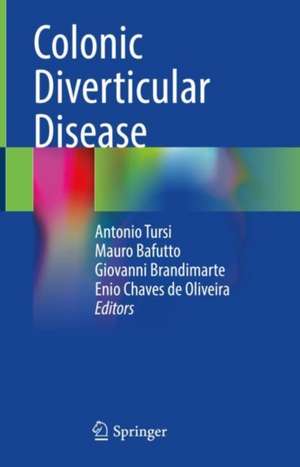Colonic Diverticular Disease
Editat de Antonio Tursi, Mauro Bafutto, Giovanni Brandimarte, Enio Chaves de Oliveiraen Limba Engleză Paperback – 2 iul 2023
The first parts of the book will deal with the disease epidemiology and etiopathogenesis, focusing on the roles of inflammation and dysbiosis as part of the pathophysiology of diverticular disease. The clinical spectrum, the diagnostic approach and differential diagnosis, medical and surgical treatments are described in the following sections. Written by experts in the field, the volume will be a unique and valuable resource for all clinicians, residents, and physicians involved in the management of this disease.
| Toate formatele și edițiile | Preț | Express |
|---|---|---|
| Paperback (1) | 717.45 lei 38-44 zile | |
| Springer International Publishing – 2 iul 2023 | 717.45 lei 38-44 zile | |
| Hardback (1) | 1105.77 lei 3-5 săpt. | |
| Springer International Publishing – iul 2022 | 1105.77 lei 3-5 săpt. |
Preț: 717.45 lei
Preț vechi: 755.21 lei
-5% Nou
137.30€ • 149.09$ • 115.33£
Carte tipărită la comandă
Livrare economică 19-25 aprilie
Specificații
ISBN-10: 3030937631
Pagini: 359
Ilustrații: XVIII, 359 p. 108 illus., 83 illus. in color.
Dimensiuni: 155 x 235 mm
Ediția:1st ed. 2022
Editura: Springer International Publishing
Colecția Springer
Locul publicării:Cham, Switzerland
Cuprins
Notă biografică
Enio Chaves Oliveira, MD PhD, Chief of the Digestive System Division, Hospital da Clinicas, Universidade Federal de Goiás, Goiânia, Brazil, is Associate Professor of Surgery, School of Medicine, Universidade Federal de Goiás, Goiânia, Brazil, and Professor at the Post-Graduated Health Science Programme at the same university. His research interests focus on diverticular disease of the colon, enteric nervous system, and inflammation. He authored 80 peer-reviewed articles and 25 book chapters. He has delivered more than 150 lectures in national and international congresses.
Antonio Tursi, MD is Chief of the Territorial Gastroenterology Service, Local Sanitary Agency Barletta-Andria-Trani, Andria, Italy and an Associate Professor of Territorial Gastroenterology at the Post-Graduate School of Gastroenterology, Catholic University, Rome, Italy. His main research interests include: diverticular disease of the colon; inflammatory bowel diseases; celiac disease. He has published over 300 articles in peer-reviewed journals (H-index 40) and 14 book chapters. He has presented more than 200 lectures in national and international congresses.Giovanni Brandimarte, MD is Chief of the Department of Internal Medicine and, Gastroenterology, “Cristo Re” Hospital, Rome, Italy. He is an Associate Professor of Psychosomatic Gastroenterology at the Post-Graduate School of Psychosomatic, College Consorsio Humanitas, Rome, Italy. His main research interests focus on: diverticular disease of the colon; celiac disease. He contributed to the fieldwith more than 155 articles in peer-reviewed journals, and 125 lectures in national and international congresses.
Textul de pe ultima copertă
The first parts of the book will deal with the disease epidemiology and etiopathogenesis, focusing on the roles of inflammation and dysbiosis as part of the pathophysiology of diverticular disease. The clinical spectrum, the diagnostic approach and differential diagnosis, medical and surgical treatments are described in the following sections.
Written by experts in the field, the volume will be a unique and valuable resource for all clinicians, residents, and physicians involved in the management of this disease.
Caracteristici
Descriere
The book provides up-to-date information on all aspects of colonic diverticular disease, particularly common in Western countries. Most people suffering from it remain asymptomatic, while about 20% develop symptoms without complications, experiencing the so-called "Symptomatic Non-Complicated Diverticular Disease" (SUDD). 10-25% of this last group eventually develop diverticulitis, with or without complications. The incidence of diverticulitis and diverticular colon disease is increasing worldwide, and is becoming a significant burden for national health systems in terms of direct and indirect costs, also because its prevalence increases with age. Unfortunately, the disease pathogenesis is relatively unknown and several aetiological factors may play a role in its onset.
The first parts of the book will deal with the disease epidemiology and etiopathogenesis, focusing on the roles of inflammation and dysbiosis as part of the pathophysiology of diverticular disease. The clinical spectrum, the diagnostic approach and differential diagnosis, medical and surgical treatments are described in the following sections. Written by experts in the field, the volume will be a unique and valuable resource for all clinicians, residents, and physicians involved in the management of this disease.
